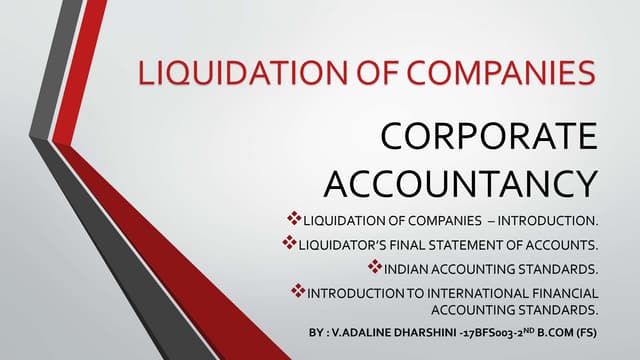The 45-Second Trick For Company Liquidation
The 45-Second Trick For Company Liquidation
Blog Article
The 9-Minute Rule for Company Liquidation
Table of ContentsWhat Does Company Liquidation Mean?What Does Company Liquidation Do?The Single Strategy To Use For Company LiquidationThe smart Trick of Company Liquidation That Nobody is Talking AboutCompany Liquidation Fundamentals Explained
A liquidator is especially designated to supervise the winding up of a firm's events in order for it to be folded normally when the company is going insolvent. The liquidator is an unbiased third event that looks after the sale of company assets in order to repay any type of outstanding financial obligations.Their function includes, yet is not restricted to: Unbiased Movie director: A liquidator is charged with working as an impartial 3rd party to oversee the entire business liquidation process. Develop Declaration of Affairs: Liquidators should produce an extensive statement of events record. This record is dispersed to lenders, outlining the present financial status of business at the time of its liquidation.
After the liquidation of a firm, its existence is removed from Firms Home and it stops to be a lawful entity. If supervisors navigated the process without issue, there would be no charges or individual liability for solid financial obligations anticipated. Now, with a tidy slate, supervisors can explore brand-new service opportunities, though professional examination is suggested.
Not known Details About Company Liquidation
If more than 90% of all firm shareholders concur, liquidation can take area on short notification within seven days, the minimum legal notice for lenders. Normally, the larger the liquidation and the even more properties and funding the organization has, the longer the procedure will certainly take.

We comprehend that no two companies are the exact same, which is why we will certainly put in the time to get to know your company so we can suggest the ideal training course of action for you. We only function in your finest rate of interests, so you can be completely certain in the solution we give.
The Buzz on Company Liquidation
In the UK, there is an established procedure to closing down or restructuring a restricted firm, whether it is solvent or bankrupt. This procedure is called liquidation and can just be managed by a qualified insolvency professional (IP) according to the Insolvency Act 1986. There are 4 primary kinds of business liquidation procedure: Creditors' Volunteer Liquidation (CVL); Required liquidation; Administration; and Members' Voluntary Liquidation (MVL).

In these conditions, it is very important that the firm ceases trading; if the business proceeds to trade, the supervisors could be held personally liable and it might cause the bankruptcy expert reporting wrongful trading, understood as misfeasance, which might bring about lawful activity. The supervisors appoint a bankruptcy specialist and once this has been agreed and verified, there is a conference with the shareholders.
Of course, if you can try these out there are no shareholders, this step of the procedure is not required (Company Liquidation). The IP takes control of the company and starts the business liquidation process. The supervisors are no much longer helpful hints associated with what occurs, including the sale of the company's properties. If the supervisors want any of the assets, they can inform the IP.
Top Guidelines Of Company Liquidation
The main difference is that the business's lenders applied to the court for an ending up order which forces the insolvent business into a liquidation procedure. In many cases, financial institutions take this activity as a last hope since they have not gotten settlement via other forms of settlement. The court assigns a bankruptcy expert, additionally referred to as a main receiver, to conduct the mandatory firm liquidation process.
This kind of firm liquidation is not volunteer and supervisors' conduct is reported to the UK's Secretary of State once the liquidation procedure has actually been finished. Any kind of director that falls short to coordinate with the IP or has actually been involved in director misbehavior, or a deceptive act, may result in serious repercussions.
It is made use of as a method to safeguard the firm from any kind of legal action by its creditors. The supervisors of the business agree to make normal payments to resolve their financial debts over a period of time. The appointed manager takes care of the volunteer management procedure, and receives the payments which they then disperse to financial institutions according to the concurred amounts.
The Ultimate Guide To Company Liquidation
This provides the firm with time to establish a plan moving forward to save the company and stay clear of liquidation. At this point, supervisors hand control of the firm over to the appointed administrator. If a firm is solvent yet the supervisors and shareholders intend to shut the service, a Members Volunteer Liquidation is the right alternative.
The company liquidation procedure is handled by a liquidator selected check it out by the supervisors and investors of the firm and they must sign an affirmation that there are no creditors remaining. The liquidation procedure for an MVL resembles that of a CVL in that possessions are know however the proceeds are dispersed to the supervisors and the shareholders of the business after the liquidator's costs have been paid.
Report this page